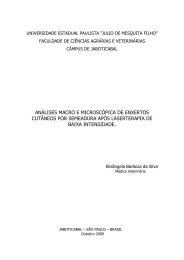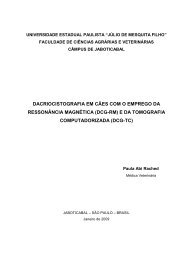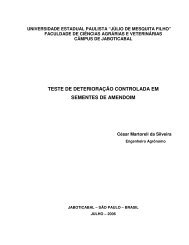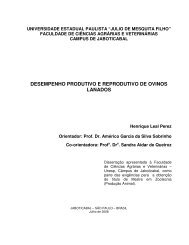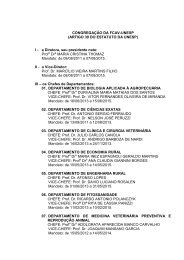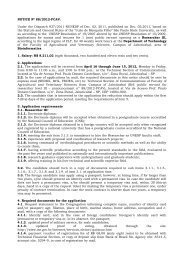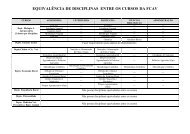visualizar - Unesp
visualizar - Unesp
visualizar - Unesp
You also want an ePaper? Increase the reach of your titles
YUMPU automatically turns print PDFs into web optimized ePapers that Google loves.
ABSTRACT - This study aims to provide information on morphological data of D. renale<br />
eggs, as well as on first-stage larvae development into eggs kept at different<br />
temperatures. Eggs were obtained by centrifugation of infected dog urine, placed in Petri<br />
dishes, and stored in BOD chamber for a 90-day period. Each treatment (GI-15ºC, GII-<br />
20ºC, and GIII-26ºC) was repeated five times. Eggs showed average measures of 67.23<br />
x 42.78 μm, and the mean incubation time was inversely proportional to the incubation<br />
temperature. Larvae motility was observed one week after being observed in eggs.<br />
Key words: Dioctophyme renale, dog, eggs, temperature.<br />
1. INTRODUÇÃO<br />
Dioctophyme renale Goeze, 1782 (Enoplida: Dioctophymatoidea), comumente<br />
chamado de verme gigante que parasita o rim, é o maior nematódeo conhecido,<br />
podendo chegar a 100 cm de comprimento por 1,2 cm de largura (ANDERSON, 2000;<br />
MONTEIRO et al., 2002; FORTES, 2004).<br />
Sua distribuição é mundial e é descrito parasitando mustelídeos e carnívoros<br />
domésticos e selvagens (ANDERSON, 2000; COSTA et al., 2004). Mustela vison<br />
(Carnivora: Mustelidae) é considerado o principal hospedeiro definitivo (BOWMAN,<br />
2006). Para alguns autores (KOMMERS et al., 1999; NAKAGAWA et al., 2007), o cão é<br />
considerado um hospedeiro definitivo anormal e terminal ou acidental (ACHA e<br />
SZYFRES, 1986).<br />
No ciclo do parasito, os ovos são eliminados com a urina do hospedeiro<br />
definitivo, e sua evolução ocorre no meio externo (ANDERSON, 2000). Os ovos são de<br />
coloração castanha, elípticos, possuem uma casca espessa e ondulada e tampões<br />
bipolares (SLOSS et al., 1999).<br />
Os ovos de D. renale tornam-se inviáveis quando são dessecados pelo sol<br />
(Lukasiak, 1930 citado por COYNER et al., 2004). A evolução no interior dos ovos<br />
ocorre apenas se estes entrarem em contato com a água de rios e se no rio houver o<br />
20



